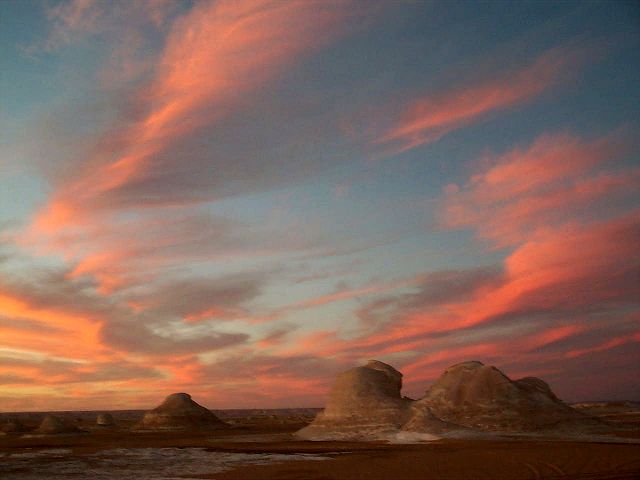![]()
The Western or Libyan Desert
|
|
The Western or Libyan Desert |

Sunset in the White Desert, Western Egypt
| The oasis cities of the Western desert |
| Some people argue that Egypt
is better without Egyptians. After having spent a week in the sparsely
inhabited Sinai desert and a night in the city of Suez that is just what
we wanted to find out. We crossed Cairo on a quiet Friday (the equivalent
of Sunday in the Western world), had our first glimpse at the pyramids,
went shopping, had a McDonalds and headed straight into the desert. With
over 90% of Egypt's 65 million people living along the Nile river,
population is scarce in the rest of the country. One of the few inhabited
area's are the desert oases in the west of the country. The Western or
Libyan desert is 2.8 million sq. km or more than 5 times the size of
France ! It stretches from Sudan to Libya to the Mediterranean Sea.
|
|
|
|
Our first glimpse at the pyramids at Giza as we stop to ask the police which is the way to the desert
|
|
|
| Late that afternoon, after
more than 200 km driving straight to the middle of nowhere, we arrived in
the oasis city of Bahariyya. It is a strange sight indeed to see greenery
in a sea of rock and sand. There were several little villages spread
throughout the oasis. Even if the main one is said to have 30,000 souls,
it is a very peaceful place.
|
|
|
|
130 km/h and no traffic police on the desert road (left), wild camping in the Bahariyya oasis (centre), palm trees and flowers in the desert (right)
|
| The next day we headed for
the White Desert. We had been given a GPS waypoint by fellow overlanders
to find the exact point where to turn off into the desert but since our PC
has been replaced by IBM, it no longer has the right port for our GPS !
Luckily, the whole area was clearly visible from several kilometers away
and several tracks leading into it were visible.
|
|
|
|
Desert sand and icebergs on the same picture
|
|
We spent several hours that afternoon driving around what is best described as a moonlike landscape. The white are rock formations that have been sculpted by centuries of wind erosion. In some areas, there was a thin layer of sand covering chalk. This lethal combination is not what we wanted to get Troopie into. We did get stuck however ! It did not take us long to recognise defeat, switch off the engine, deflate the tyres and start digging with our newly bought shovel ! 15 minutes of playing in the sand under the car is all it took us to get free... The feeling of water flowing over our dry sandy hands and face is something unforgettable.
|
|
|
|
Powder chalk hidden right under the sand (left), stuck in the Sahara for the first time (centre), out of trouble (right)
|
| Later that afternoon we set
up camp and started one of the few fires we have lit during this journey.
As the sun started to set, we were blessed with incredible colours. When
all we could see were the stars above our heads, we called our dads to let
them know where we were and to try and share the magic of what we had just
witnessed !
|
|
|
|
Ready for a quiet night out in the desert (left), strange mushroom-like rock formations (centre), snow-like rock in the desert (right)
|
|
|
|
Driving through a sea of sand, on our way to the Dakhla oasis
|
|
|
|
Al Qsar and its labyrinthine streets in the old mud-brick city of the Dakhla oasis
|
|
|
|
Lintels in Qsar: acacia beams situated above the door and carved with the names of the carpenter, the owner of the house, the date and a verse from the Quran
|
|
|
|
The journey, not the destination !
|
We are doing well !
| Here are our extra pages on Egypt I : | |||
|
|||
|
| Coming from Jordan | Back to Trip page | Egypt, part II |